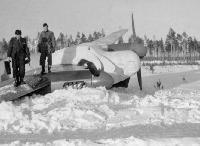Фотографии
-
Bearing the yellow spinners and code letter “C” of No 3 Sqn, a J 30 taxies in during a visit to Wing F 8 at Barkarby, north of Stockholm. Visible behind the Mosquito is the tail of one of the 198 Swedish-designed and -built FFVS J 22 single-engined fighters built during 1942-46, the type finally being retired from service in 1952.
Самолёты на фотографии: De Havilland Mosquito F - Великобритания - 1941FFVS J-22 - Швеция - 1943
-
de Havilland J 30 (Mosquito NF.19) 30018 (formerly TA252) of No 2 Sqn, Wing F 1, based at Vasteras circa 1950
Самолёты на фотографии: De Havilland Mosquito F - Великобритания - 1941
-
Flygvapnet delivery pilots pose for publicity photographs at Hatfield before ferrying the Mosquitoes to Sweden in February 1949. The first of the J 30s delivered to Sweden, 30001 (formerly TA286), was delivered in July 1948 in an overall aluminium dope scheme with black propeller spinners. Most of the remainder were delivered in the standard RAF nightfighter camouflage scheme with Swedish serials added plus the spinners and code letters in the various colours used by the three squadrons of Wing F1 at Vasteras.
Самолёты на фотографии: De Havilland Mosquito F - Великобритания - 1941
-
One of a consignment of six Mosquito NF.19s for the Swedish Air Force (Flygvapnet) departs Hatfield on the first stage of its delivery flight on February 26, 1949. The first example had been delivered in July 1948, and a total of 60 were to arrive in Sweden by November 1949. Somewhat spoiling the Mosquito’s usually graceful profile, the nightfighter’s “bull” nose housed the all-important Al Mk X airborne interception radar equipment.
Самолёты на фотографии: De Havilland Mosquito F - Великобритания - 1941
-
Mosquito ‘‘Blue K” of Wing F 1's No 2 Sqn keeps formation with another J 30. The Wing incorporated three J 30 nightfighter units, Nos 1, 2 and 3 Sqns, each distinguished by a signature colour applied to the spinners and code letters on the fin. Initially white, No 1 Sqn’s colour was ultimately red, No 2 was blue and No 3 wore yellow.
Самолёты на фотографии: De Havilland Mosquito F - Великобритания - 1941
-
Swedish Mosquitoes await their delivery flights at Hatfield. As with most export Mosquitoes, the Swedish examples were all former RAF machines bought back by de Havilland and sent to Fairey Aviation at Ring way, Manchester, to be refurbished and modified (including the replacement of three-bladed props with four-bladers) before being flown back to Hatfield for their onward journey.
Самолёты на фотографии: De Havilland Mosquito F - Великобритания - 1941
-
The “A” on the fin of this J 30, and its spinners, are probably red, making it a No 1 Sqn machine. The Al Mk X radar equipment housed in the J 30’s nose had been designed by the Radiation Laboratory of the Massachusetts Institute of Technology using British cavity magnetron technology.
Самолёты на фотографии: De Havilland Mosquito F - Великобритания - 1941
-
With no unit markings or serials visible, this J 30 was probably photographed while up on a pre-delivery flight from Hatfield. The NF.19 variant was powered by a pair of Rolls-Royce Merlin 25s and first flew in April 1944.
Самолёты на фотографии: De Havilland Mosquito F - Великобритания - 1941
-
An example of the comparatively frequent fate of Flygvapnet’s Mosquitoes. Following engine trouble the crew of this J 30 managed to make a forced landing at Wing F 21 at Lulea-Kallax. The airframe suffered substantial damage, however, and was struck off charge.
Самолёты на фотографии: De Havilland Mosquito F - Великобритания - 1941
-
Radar installation of Mosquito NF.19
Самолёты на фотографии: De Havilland Mosquito F - Великобритания - 1941
Статьи
- -
- A.Harris - Under Development
- A.Waller - A Flying Safari
- B.Hales-Dutton - A Day of Triumph and Tragedy
- B.Lindwall - Mosquito vs Bull: Fliying the J 30 in Flygvapnet service
- D.Menzies - "A Very Audible Remark..."
- E.Brown - Big Cat Diary
- F.Merriam - Early Days at Eastchurch /Echoes from Dawn Skies/ (1)
- G.Alegi - Secondo's Slow Burner: Campini, Caproni and the C.C.2
- G.Ellis - Hunting the Lion of Afrika
- G.Skillen - Terminal Velocity
- H.Carter - Fit for the King
- J.Forsgren - Sweden's midnight Mosquitoes
- P.Davidson - Off the Beaten Track...
- P.Jarrett - Lost & Found
- R.Lezon - Reimar's little Ray of Sunshine
- R.Simpson - Elegant Imperfection
- R.Tisdale, A.Vercamer - Before & After









